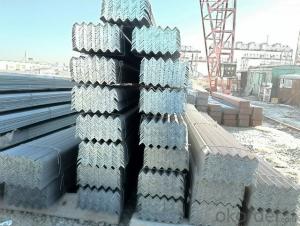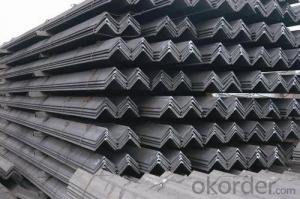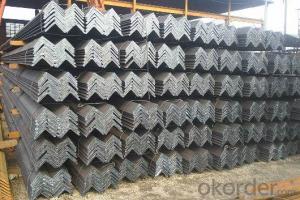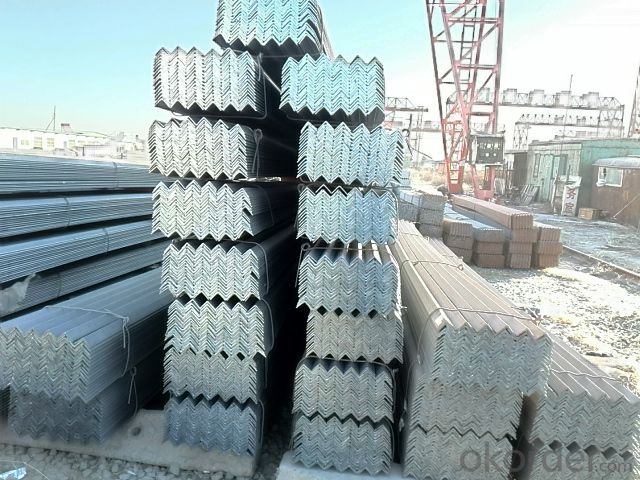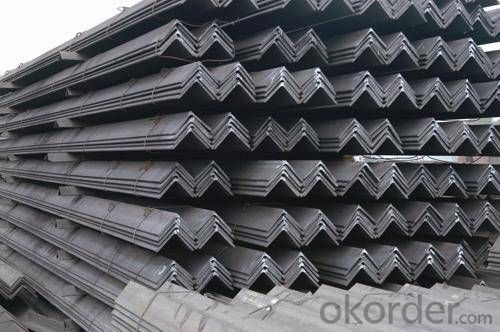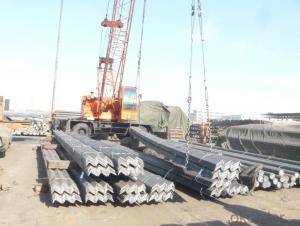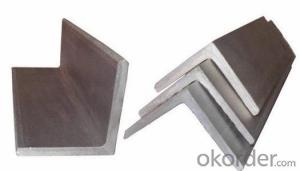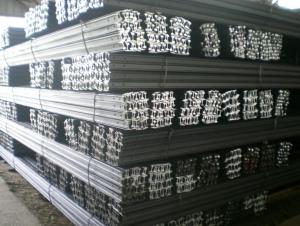Steel angle bar
- Loading Port:
- China Main Port
- Payment Terms:
- TT OR LC
- Min Order Qty:
- -
- Supply Capability:
- -
OKorder Service Pledge
OKorder Financial Service
You Might Also Like
Product Description:
Specifications of Angle Steel
1. Invoicing on theoretical weight or actual weight as customer request
2. Length: 6m, 9m, 12m as following table
3. Sizes

Sizes: 25mm-250mm | ||
a*t | ||
25*2.5-4.0 | 70*6.0-9.0 | 130*9.0-15 |
30*2.5-6.6 | 75*6.0-9.0 | 140*10-14 |
36*3.0-5.0 | 80*5.0-10 | 150*10-20 |
38*2.3-6.0 | 90*7.0-10 | 160*10-16 |
40*3.0-5.0 | 100*6.0-12 | 175*12-15 |
45*4.0-6.0 | 110*8.0-10 | 180*12-18 |
50*4.0-6.0 | 120*6.0-15 | 200*14-25 |
60*4.0-8.0 | 125*8.0-14 | 250*25 |
5. Payment terms:
1).100% irrevocable L/C at sight.
2).30% T/T prepaid and the balance against the copy of B/L.
3).30% T/T prepaid and the balance against L/C
6.Material details:
Alloy No | Grade | Element (%) | | ||||
C | Mn | S | P | Si | | ||
| | |||||||
|
|
|
|
|
|
| |
Q235 | B | 0.12—0.20 | 0.3—0.7 | ≤0.045 | ≤0.045 | ≤0.3 | |
|
|
|
|
|
|
| |
Alloy No | Grade | Yielding strength point( Mpa) | | ||||
Thickness (mm) | | ||||||
≤16 | >16--40 | >40--60 | >60--100 | | |||
≥ | | ||||||
|
|
|
|
|
| | |
Q235 | B | 235 | 225 | 215 | 205 | | |
Alloy No | Grade | Tensile strength (Mpa) | Elongation after fracture (%) | | |||
Thickness (mm) | | ||||||
| ≤16 | >16--40 | >40--60 | >60--100 | | ||
≥ | | ||||||
|
|
|
|
|
|
| |
Q235 | B | 375--500 | 26 | 25 | 24 | 23 | |
Usage & Applications of Angle Steel
According to the needs of different structures, Angle can compose to different force support component, and also can be the connections between components. It is widely used in various building structures and engineering structures such as roof beams, bridges, transmission towers, hoisting machinery and transport machinery, ships, industrial furnaces, reaction tower, container frame and warehouse etc.
Packaging & Delivery of Angle Steel
1. Packing: it is nude packed in bundles by steel wire rod
2. Bundle weight: not more than 3.5MT for bulk vessel; less than 3 MT for container load
3. Marks:
Color marking: There will be color marking on both end of the bundle for the cargo delivered by bulk vessel. That makes it easily to distinguish at the destination port.
Tag mark: there will be tag mark tied up on the bundles. The information usually including supplier logo and name, product name, made in China, shipping marks and other information request by the customer.
If loading by container the marking is not needed, but we will prepare it as customer request.
Production flow of Angle Steel
Material prepare (billet) —heat up—rough rolling—precision rolling—cooling—packing—storage and transportation
- Q: Can steel angles be used for acoustic isolation or noise barriers?
- No, steel angles are not typically used for acoustic isolation or noise barriers as they do not possess the necessary properties to effectively block or absorb sound. Other materials such as acoustic panels or specialized barriers are more commonly used for this purpose.
- Q: Can steel angles be used in the construction of agricultural buildings?
- Certainly, agricultural buildings can definitely utilize steel angles for construction purposes. These versatile and long-lasting building materials offer numerous advantages in the creation of agricultural structures. To begin with, steel angles provide exceptional support and stability. They can be employed to establish robust frameworks for walls, roofs, and other essential structural elements within agricultural buildings. This aspect is particularly crucial as these structures often house heavy machinery and equipment, necessitating durability against harsh weather conditions and potential impact from animals or other external factors. Moreover, steel angles possess high resistance to corrosion and rust, making them an ideal choice for agricultural buildings exposed to moisture, chemicals, and other potentially corrosive substances. This resistance ensures the longevity and strength of the structure, reducing the need for frequent maintenance and repairs. Additionally, steel angles come in various sizes and shapes, enabling flexibility in design and construction. They can be easily customized and cut to fit specific building requirements, making them adaptable to different agricultural building designs. Furthermore, steel angles can be conveniently welded or bolted together, streamlining the construction process and reducing costs. Lastly, steel angles are an environmentally sustainable choice for agricultural buildings. Steel is a recyclable material, allowing it to be reused or repurposed once the building has reached the end of its life cycle. This not only reduces the environmental impact but also promotes sustainability within the construction industry. In conclusion, due to their structural strength, corrosion resistance, design flexibility, and sustainability, steel angles can be effectively utilized in the construction of agricultural buildings.
- Q: How many kilograms per square meter is angle steel 63*63*6?
- The dimension of angle iron is expressed by the dimension of the length of side and the thickness of edge. At present, the domestic steel specifications for 2 - 20 cm, to length number number, the same horn steel often have 2 - 7 different edge thickness. Imported steel angles indicate the actual sizes and edges of both sides and indicate the relevant standards. Generally, the length of 12.5cm is larger than that of angle steel, and between 12.5cm and 5cm is medium angle steel. The angle of 5cm is smaller than that of angle steel.
- Q: How do steel angles perform under vibration or resonance conditions?
- Steel angles are widely recognized for their exceptional structural properties, specifically their ability to endure vibrations and resonance circumstances. In the presence of vibrations, steel angles demonstrate impressive stiffness and damping characteristics, allowing them to proficiently dissipate the energy generated by these vibrations. This behavior is a result of the inherent material properties of steel, including its substantial strength and rigidity. Additionally, steel angles exhibit commendable performance under resonance conditions. Resonance arises when the frequency of external excitation matches the natural frequency of the steel angle. In such instances, the steel angle may encounter amplified vibrations that could potentially lead to structural failure if not adequately addressed. Nevertheless, steel angles are meticulously designed and fabricated with resonance considerations in mind, guaranteeing their capacity to withstand and alleviate the repercussions of resonance. To further enhance the performance of steel angles under vibration or resonance conditions, engineers can employ an array of techniques. These techniques encompass the incorporation of damping materials or devices to absorb or dissipate vibrational energy, the alteration of the geometric properties of the steel angle to modify its natural frequency, and the utilization of vibration isolation systems to minimize the transmission of vibrations to the steel angle. In conclusion, steel angles are exceptionally suitable for applications that require resistance to vibrations or resonance conditions. Their remarkable strength, stiffness, and damping properties enable them to effectively withstand and mitigate the effects of vibrations, thereby ensuring the integrity and stability of the structure in which they are employed.
- Q: Are steel angles suitable for window frames?
- Yes, steel angles are suitable for window frames. Steel angles are often used in construction for their strength and durability, making them an ideal choice for supporting the weight of window frames. They provide excellent structural support, ensuring that the window frames remain stable and secure. Additionally, steel angles are resistant to corrosion, which is particularly advantageous for window frames that are exposed to external elements such as rain and humidity. Furthermore, steel angles can be easily fabricated and customized to meet specific design requirements, making them a versatile option for window frame construction. Overall, steel angles offer numerous benefits that make them a suitable choice for window frames in terms of strength, durability, corrosion resistance, and flexibility.
- Q: How do steel angles contribute to the seismic resilience of a structure?
- Steel angles contribute to the seismic resilience of a structure by providing structural stability and strength. These angles are commonly used as bracing elements to reinforce the connections between different components of the building, such as beams and columns. By distributing and dissipating seismic forces, steel angles help to reduce the impact of earthquakes on the structure. They enhance the overall stiffness and rigidity of the building, preventing excessive deformation and potential collapse during seismic events. Additionally, steel angles can act as energy-absorbing devices, absorbing and dissipating seismic energy, thereby improving the seismic performance and resilience of the structure.
- Q: Are steel angles suitable for balcony construction?
- Indeed, balcony construction can make use of steel angles as they possess the necessary qualities of strength and durability. In construction, steel angles find frequent application due to their exceptional support and stability, rendering them an ideal choice for balcony construction. The capacity of steel angles to withstand heavy loads and resist weathering and corrosion further solidifies their reliability for outdoor structures like balconies. Moreover, the customizable and fabricable nature of steel angles enables them to be tailored to specific design requirements, offering flexibility in balcony construction. Ultimately, the strength, durability, and versatility of steel angles contribute to their popularity and suitability for balcony construction.
- Q: What are the different methods for joining steel angles?
- There exist various techniques for connecting steel angles, each possessing its own advantages and applications. Welding, bolting, and utilizing adhesive or epoxy are among the most frequently employed methods. Welding is a favored approach for joining steel angles due to its capacity to establish a sturdy and enduring connection. The process involves melting the edges of the angles using a welding torch, allowing them to cool and solidify, thereby creating a bond between the two pieces. Depending on the project's specific requirements, welding can be executed using diverse techniques such as arc welding, MIG welding, or TIG welding. Bolting is another commonly utilized method for joining steel angles, whereby nuts and bolts are employed to secure the angles together. This technique permits easy disassembly and reassembly, making it suitable for scenarios that demand flexibility. Additionally, bolting does not require any heat or special equipment, rendering it a relatively straightforward and cost-effective option. Utilizing adhesive or epoxy represents a non-traditional technique for connecting steel angles. This method involves the application of a potent adhesive or epoxy onto the contact surfaces of the angles, which are subsequently pressed together. Particularly when employing high-strength adhesives designed for metal bonding, this approach can yield a robust and long-lasting bond. Adhesive bonding is often employed in situations where welding or bolting may prove impractical or undesirable, such as when dealing with thin or delicate materials. Ultimately, the selection of a joining method for steel angles depends on various factors, including the specific application, desired strength and durability, ease of installation, and the necessity for disassembly or flexibility. Consulting with an expert or engineer is recommended to determine the most suitable joining method for a particular project.
- Q: Can steel angles be used in architectural applications?
- Certainly, architectural applications can make use of steel angles. Due to their impressive strength, durability, and versatility, steel angles are frequently employed in construction and architectural projects. They serve a variety of purposes, including providing structural support, reinforcing corners and edges, and creating visually appealing designs. Buildings, bridges, and other structures often incorporate steel angles to enhance stability and support. Moreover, steel angles can be utilized to fashion architectural elements like decorative trim, handrails, and window frames. Furthermore, architects and designers favor steel angles because they can be easily fabricated and customized to meet specific design requirements.
- Q: What is the process of cold bending steel angles?
- Manipulating steel angles into a desired shape without using heat is the process of cold bending. This involves applying force or pressure to the angles in a controlled manner. To begin, a bending machine or fixture securely holds the steel angle in place during bending. The operator then determines the desired angle and bend radius, which dictate the required force. Subsequently, pressure is gradually applied by the bending machine or fixture to bend the steel angle to the desired shape. This force is applied slowly and evenly to prevent any deformation or damage. Throughout the bending process, it is crucial to monitor the angle and ensure even and smooth bending. Adjustments to the pressure or angle may be necessary to achieve the desired shape. Once the steel angle has been bent to the desired angle, it is cautiously removed from the bending machine or fixture to prevent any distortion or damage. Cold bending steel angles have various advantages over hot bending, including reduced risk of material distortion or weakening caused by heat. It also allows for more precise and controlled bending, making it ideal for applications where accuracy is vital. In conclusion, cold bending steel angles involves securely positioning the angle in a bending machine or fixture, applying gradual and controlled pressure to bend it to the desired shape, and carefully removing the bent angle for further use.
Send your message to us
Steel angle bar
- Loading Port:
- China Main Port
- Payment Terms:
- TT OR LC
- Min Order Qty:
- -
- Supply Capability:
- -
OKorder Service Pledge
OKorder Financial Service
Similar products
Hot products
Hot Searches
Related keywords
